“Every father should remember one day his son will follow his example, not his advice.” ― Charles F. Kettering

Happy Father’s Day to all who tenderly embrace a child!
Finding Contentment in Every Situation
Finding Contentment in Every Situation
“Every father should remember one day his son will follow his example, not his advice.” ― Charles F. Kettering

Happy Father’s Day to all who tenderly embrace a child!
“When I stand before God at the end of my life, I would hope that I would not have a single bit of talent left, and could say, ‘I used everything you gave me.”
―
.
Marvin, he was a friend of mine
And he could sing his song
His heart in every line
Marvin, sang of the joy and pain
He opened up our minds
And I still can hear him say
Oh talk to me, so you can see, what’s goin’ on
Say you will, sing your songs, for evermore, evermore
Gonna be some sweet sounds
Comin’ down, on the nightshift
I bet you’re singing proud
Oh, I bet you’ll pull a crowd
Gonna be a long night
It’s gonna be all right, on the nightshift
You found another home
I know you’re not alone, on the nightshift, oooh
You found another home
I know you’re not alone, on the nightshift
Jackie, mmmm, hey what you doing now
It seems like yesterday, when we were working out
Jackie, oh, you set the world on fire
You came and gifted us
Your love it lifted us higher and higher
Keep it up, and we’ll be there at your side
Oh, say you will, sing your songs
For evermore, evermore, evermore
Gonna be some sweet sounds
Comin’ down, on the nightshift
I bet you’re singing proud
Oh I bet you’ll pull a crowd
Gonna be a long night (gonna be a long night)
It’s gonna be alright, on the nightshift
You found another home
I know you’re not alone, on the nightshift
Gonna be some sweet sounds (sweet sounds)
Comin’ down, on the nightshift (oh on the nightshift)
I bet you’re singing proud (I know you’re singing proud)
Oh, I bet you’ll pull a crowd (oh yeah)
Gonna be a long night (gonna be alright) it’s gonna be alright
On the nightshift, on the nightshift
You found another home
I know you’re not alone, on the nightshift
Gonna miss your sweet voice, (sweet)
That soulful noise (soulful noise)
On the nightshift, nightshift (on the nightshift)
We all remember you, remember you, remember you
Oooh you’re songs are comin’ through
Oh oooh oh oooh oh oh oh
At the end of a long day (a long day)
It’s gonna be OK (OK)
On the nightshift, nightshift
You found another home
I know you’re not alone, on the nightshift
Gonna be some sweet sounds, sweet sweet sounds
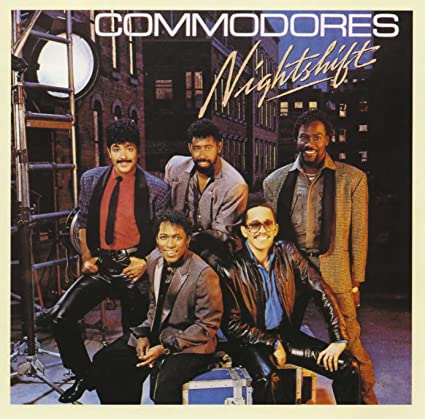
“There is only one happiness in this life, to love and be loved.” ― George Sand
.
MAIS JE T’AIME
– Grand Corps Malade & Camille Lellouche –
Mais me raconte pas d’histoires
Tu sais bien, ce qui ne tourne pas rond
Chez moi, ne m’en demande pas trop
Tu sais bien, que les fêlures sont profondes
Sans moi, ne t’accroche pas si fort
Si tu doutes, ne t’accroche pas si fort
Si ça te coûte, ne me laisse pas te quitter
Alors que je suis sûre de moi
Je te donne tout ce que j’ai alors essaie de voir en moi que
Je t’aime
Mais je t’aime
Je t’aime
Je t’aime
Je t’aime
Je t’aime
Je t’aime, du plus fort que je peux
Je t’aime, et je fais de mon mieux
On m’avait dit “Attends tu vas voir, l’amour c’est un grand feu”
Ça crépite, ça illumine, ça brille, ça réchauffe, ça pique les yeux
Ça envoie des centaines de lucioles tout là-haut, au firmament
Ça s’allume d’un coup et ça éclaire le monde et la ville différemment
Nous on a craqué l’allumette pour l’étincelle de nos débuts
On a alimenté ce foyer de tous nos excès, de nos abus
On s’est aimé plus que tout, seul au monde de notre bulle
Ces flammes nous ont rendus fous
On a oublié qu’au final, le feu ça brûle
Et je t’aime
Je t’aime
Je t’aime
Je t’aime
Oui, je t’aime
Je t’aime
Je t’aime, du plus fort que je peux
Je t’aime, et je fais de mon mieux
Je m’approche tout près de notre feu et je transpire d’amertume
Je vois danser ces flammes jaunes et bleues, et la passion qui se consume
Pourquoi lorsque l’amour est fort il nous rend vulnérables et fragiles
Je pense à nous et je vacille, pourquoi depuis rien n’est facile
Je t’aime en feu, je t’aime en or
Je t’aime soucieux, je t’aime trop fort
Je t’aime pour deux, je t’aime à tord
C’est périlleux, je t’aime encore
Alors c’est vrai ça me perfore
Je t’aime pesant, je t’aime bancale
Évidemment ça me dévore
Je sais tellement que je t’aime, mal
Si j’avance, avec toi
C’est que je me vois faire cette danse, dans tes bras
Des attentes, j’en ai pas
Tu me donnes tant d’amour, tant de force
Que je ne peux plus, me passer d’toi
Si mes mots te blessent, c’est pas de ta faute
Mes blessures sont d’hier
Il y a des jours plus durs que d’autres
Si mes mots te pèsent
J’y suis pour rien
J’y suis pour rien, rien
Mais, je t’aime
Je t’aime
Je t’aime
Je t’aime
Je t’aime
Je t’aime
Je t’aime, du plus fort que je peux
Je t’aime (Tu m’aimes), et je fais de mon mieux (Tu fais de ton mieux)
Mais, je t’aime (je t’aime)

Click here for the English translation.
When designing our gardens thirteen years ago, we didn’t think about wildlife, we simply wanted to create a simple and relaxing atmosphere both in the front yard and back. As time went by our gardens became an attraction to various wildlife, so much that we had to take drastic actions to protect ourselves and our plants. We have many dense native bushes, shrubs and trees all over our property, which attract birds, hummingbirds, lizards, butterflies, bees, ladybugs, beetles, dragonfly, wasps, hoverflies, stink bugs, praying mantises, garden spiders, and much more (most of which are beneficial garden insects). These plants are nesting sites for birds, most of which prefer the front yard. We have bird feeders, bird baths, and water fountains all around our gardens to keep the birds and other wildlife happy.
Eight years ago we built two birdhouses in the backyard, one of which is double sided. A few years ago, a bird built its nest in one of them and laid ten eggs. Everything seemed to be going fine, the eggs hatched, and both parents went back and forth looking for food and caring for their young. At some point we noticed that the baby birds were constantly chirping and found one of the ground, dead. The parents eventually abandoned their babies most likely due to shortage of food and the remaining nine eventually died in the nest.
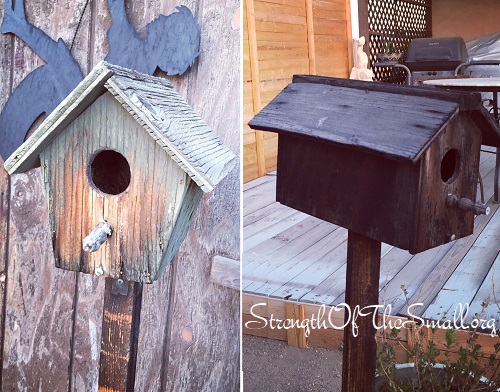
Early this month, a female House Finch laid five eggs in the nest. One of the nestlings fell out of the nest, in what seemed like an attempt to take flight, and didn’t make it. The remaining four flew from the nest a few weeks later.
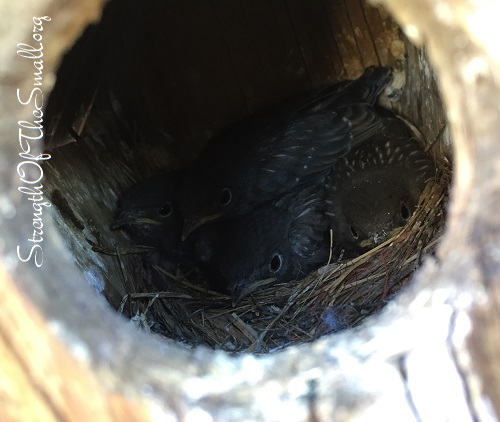
Last weekend while fastening Jasmine vines to a trellis, I saw a bird nest with five tiny eggs hidden among the leaves of the climbing Jasmine. I don’t know why this nesting place was chosen; perhaps it offered camouflage and protection, or because other birds have successfully raised their nestlings nearby.
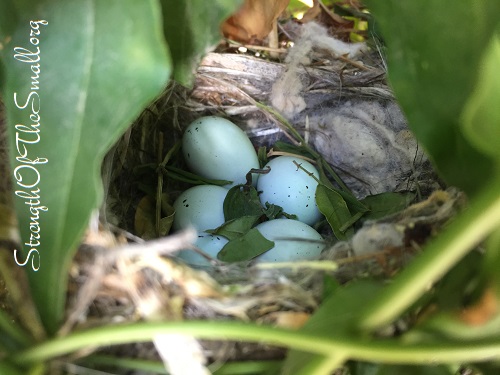
A few days later, we found two dead featherless chicks on the ground and realized the nest had been disturbed. We suspected a crow, since one of the chicks had disappeared. We moved the nest back in place, secured the opening, and hoped the last two eggs would make it.
On Tuesday, we found vines on the ground and noticed that the nest was pulled forward. One of the last two recently hatched chicks had vanished and the last one was lifeless.
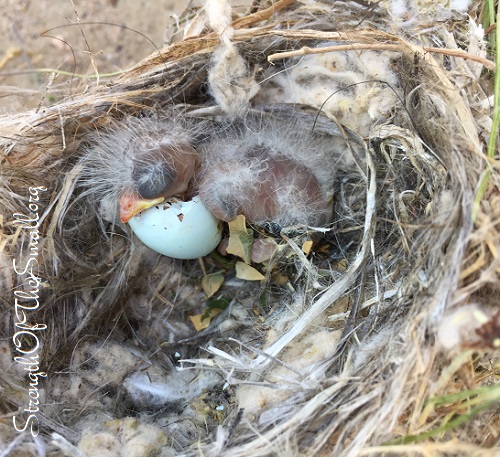
Our backyard is the heart of our home and the place we explore and observe. For now we are looking into ways to better protect and secure the bird nests from predators.
Last October I wrote about the The Fascinating Life of Mantises and shared a video of a praying mantis laying eggs. We decided, early in the Spring, to get one ootheca (egg case) and observe it indoor until it hatches.
For this observation we used a jar, a dryer sheet and rubber band (to secure the opening of the jar), and a small branch from the Pomegranate tree. We placed a branch in the jar and gently stuck the egg case on one of the thorns of the branch so that it would be suspended and also, for the praying mantis nymphs to perch on once they emerge. The dryer sheet was a used one, very soft and breathable, allowing air to flow into, out of, and within the jar.
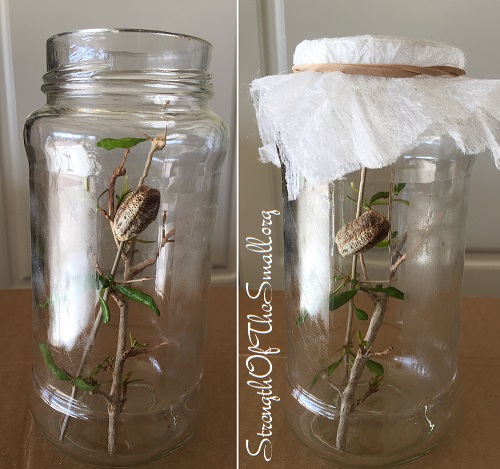
We had the egg case in a jar for about five weeks and watched with delight as nymphs emerged from the egg case last week.
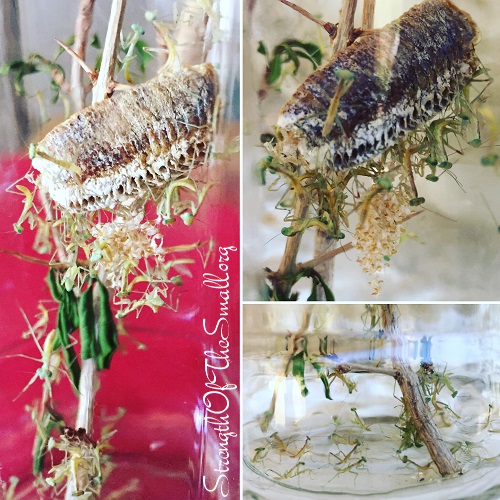
And no, young mantises do not eat one another as soon as they hatch. Not releasing them soon enough, however, will cause them themselves to become prey. We gently released them on the leaves of a rose bush, to start feeding on aphids and hide from predators.